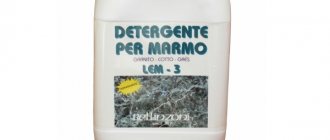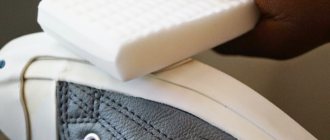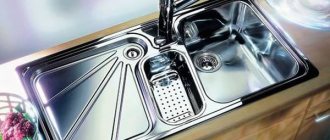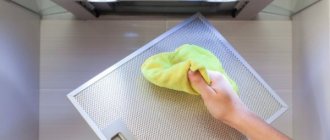Marble has been used by mankind as a decorative material since ancient times. Unique data on its processing have survived to this day, but not everyone knows that it needs careful care. Cleaning marble is a painstaking process that must be carried out according to certain specifications. Neglecting them will certainly lead to loss of attractiveness and damage to the integrity of the product.
In most European countries, people who use marble in interior design take care of it and pay special attention to its protection. In our area, people think less about caring for their floors, as a result of which the stone darkens and loses its original appearance.
Caring for Marble Floors
The peculiarity of the porous structure dictates its own rules for caring for the material. To prevent it from wearing out, losing its shine and deforming, you need to regularly clean the surface from dirt that gets stuck in the seams and microcracks. It is important to clean up spilled alcohol, coffee or ketchup stains immediately, as they eat into the floor and change its color.
It is better to wash marble floors with special cleaning compounds, as well as regularly carry out preventive cleaning. These steps will help avoid frequent sanding to restore shine. Since acids in detergent can damage marble, choose products that contain mild chemicals. In this case, special cleaners need to be diluted only in clean water to protect against smudges. If you wash light-colored tiles with rusty water, the surface will quickly absorb dirt and give an unaesthetic tint.
In order for the floor to be thoroughly cleaned, you need to use products for cleaning marble and the specific type of dirt. There are cleaners for deep and greasy stains, paint, soot or rust. Select products taking into account the specifics of contamination, study recommendations from manufacturers. It is better to avoid traditional methods, since these are untested solutions that can harm the coating.
Heavy contamination can be removed with cleaning concentrates. However, the solution content should be increased as needed. It is better to start cleaning marble with a more gentle product. Otherwise, there is a possibility of making the surface matte.
Fighting stains
Any stains on a marble floor, especially difficult ones, should be removed as quickly as possible, cleaning the tiles frequently so that you don’t have to resort to sanding and polishing later.
Organic stains
It is quite easy to determine that the stains are from products of organic origin - they acquire a characteristic light pink tint. Special products for removing stains from marble, such as Akemi Stone Cleaner, work well with this problem:
- dilute with water in a ratio of 1:1 to 1:50, depending on the contamination, and apply to the surface of the stone;
- wait 10 to 20 minutes;
- Clean the surface of the stone using a water vacuum cleaner.
Vegetable stains
Effective specialized products, such as Akemi Soft Soap, can clean stone floors from such contaminants. It's easy to use:
- mix 1-2 tablespoons (20-40 ml) of soap with 10 liters of water;
- Wash the floor; no additional cleaning is required.
Rust stains
Only professional products and specialized compounds will help get rid of such pollution. Clean carefully, strictly follow the manufacturer's instructions and do not leave the substance on the floor surface for a long time. It is difficult to remove neglected rust stains, so do not forget about timely care of the coating.
How to remove plant stains
Oil or wax stains, as well as traces of soot, are best removed using anti-grease detergents. They contain an effective concentrate that easily removes dirt. If there is no chemicals, you can quickly remove oil stains by using blotting paper soaked in alcohol. It is enough to apply the product to the area, cover with a bag and wait for the contamination to be absorbed. Then wipe the floor dry.
Removing stains from marble surfaces
In order to effectively remove stains from natural stone, it is necessary to identify what caused the appearance of this or that contamination, and only then think about what to wash with.
Divorces
If stains appear from non-coloring liquids, you can remove them as follows:
- Once you notice a wet spot, blot it with a paper towel . You cannot rub , as this will increase the area of the spill, and you will simply rub moisture into the pores of the stone.
- Use a sponge dipped in a mild soap solution to wipe the stained area.
- Use a towel to remove any excess moisture .
- Polish the surface with a dry soft cloth, and then there will be no more streaks.
Organic stains: coffee, tea, tobacco, juice, soda
It is easy to determine that it was organic products that left stains on the marble, because they turn slightly pink. If contamination appears on marble that is located outdoors, then you don’t have to worry - it will wash off on its own with rain or fade in the sun.
Such processes do not occur indoors, so bleach must be used for removal.
How to clean marble using hydrogen peroxide and ammonia:
- The two substances must be mixed in equal quantities and applied to the stain.
- Leave for 24 hours .
- Remove any remaining cleaning solution with a napkin and rinse with water .
- Wipe thoroughly.
Grease and oil stains, lotions, cosmetics
Such substances leave dark marks on the stone.
You can remove them using a natural absorbent, starch is best suited:
- It is poured directly onto the stain and left for several hours , the procedure is repeated until the stain completely disappears.
- Then the surface must be thoroughly washed using any cleaning agent for natural stone.
If the stain does not come off the first time, you can try using a solvent to clean the marble:
- Soak several paper napkins in acetone and place on the stain .
- After a few minutes, everything can be removed , and the room must be well ventilated.
Rust
To remove this stain, you must use professional marble cleaners. Rust Eater gel is the best choice. Use it to wash stone surfaces according to the instructions on the package.
Plant contamination: mold, algae, fungus
Such stains can be easily removed using a mixture of hydrogen peroxide and ammonia.
Ink
Such contaminants can also be easily removed with peroxide and ammonia. But these substances can only be used for white marble; for dark stone, acetone is the ideal solution. The cleaned surface can be further polished with wax.
How to restore shine to your floor
Over time, marble coating loses its natural appearance, and this process can be accelerated by improper or careless use. Special wax-based polishing compounds help restore the coating. They make the surface bright and the texture pronounced. Such products can be applied independently, without special preparation, and they also provide additional protection against mechanical contacts.
An effective way to restore the shine of marble is to use special pastes or powders that are designed for cleaning and polishing stone. After their application, a protective layer is formed on the floor, which protects against scratches, chips, exposure to ultraviolet radiation or water. In addition, the treated coating is easier to clean from simple contaminants.
How to prevent the formation of stains and prevent the destruction of marble?
If the marble floor is in the hallway, you should protect the surface and lay out a rug, otherwise street dirt and sand stuck to your shoes will definitely leave scratches.
You should not walk on natural stone floors in your home with shoes. The best way to preserve its original appearance is to walk on it barefoot, which, however, is not always possible.
A marble countertop is a stylish decorative element, but it gets dirty easily. Therefore, it is imperative to use cutting boards for cutting food.
Glass glasses must be placed on special stands, especially glasses with wine. Hot dishes should also not be placed on an unprotected stone countertop.
Only specialized products should be used for marble, and then at home, natural stone will retain its original appearance for a long time.
How to properly care
Proper care of a marble floor is considered to be regular washing, as well as consistent cleaning and protection of the coating, which is carried out when it is heavily soiled or loses its shine. In addition to sanding/polishing, it is important to apply special grease- and water-repellent compounds. The nature of the floor deformation affects the list of selected works.
It is recommended to care for marble in the following sequence:
- Dry wash. To do this, use a regular brush with hard or soft bristles. Pre-treatment allows you to remove particles of sand, dust and other light contaminants from the tiles that scratch the coating.
- Wet wash. Marble tiles are treated with cleaning agents selected taking into account the degree and type of contamination. The cleaner or diluted concentrate is applied to the surface for a short time. The composition reacts and destroys contaminants, making them easy to remove. Strong cleaners should only be used in the presence of heavily ingrained dirt.
- Drying the floor. It is better if the coating dries naturally - this will avoid the formation of additional smudges or stains. However, you can speed up the process with a special tool or rag.
- Polishing. Used if the floor covering is severely damaged. Polishing with special machines with abrasive attachments allows you to remove small scratches, chips, and helps restore the surface to its natural shine.
- Floor protection. For this purpose, protective coatings in the form of wax are used, as well as impregnations to protect against grease and water. The products prevent the formation of stains and provide multi-level protection that protects marble from the effects of mechanical contacts.
Overview of special care products
There are many professional cleaners specifically for marble surfaces that will help keep your floors clean and shiny. They contain the correct pH level. Before use, carefully read the instructions. When choosing a detergent, it is advisable to consult with the stone manufacturer.
Stone Care kit
This set includes 3 products of 200 ml each. To clean the stone, it penetrates deep into the pores, draws out dirt, and cleans the surface. The protective coating is sprayed in a thin layer and wiped with a clean cloth. The polish is applied in an even layer to add shine.
Spray Rr/1
A popular foam product for home stone care. It is a spray for cleaning and adding shine.
Magnia Macchia
Stain remover paste is specially designed to remove traces of oil, coffee, and wine from marble surfaces. Removes deep stains and restores the beauty of the stone.
Detergent Lem-3
Concentrated detergent is designed to remove dirt and stains from marble, granite, and ceramics. Used in dilution with water and in pure form.
Rust eater
Gel for removing rust stains from marble, granite. Does not contain acids, applicable to all types of stone.
Stone Tech
Professional products for cleaning marble surfaces, used in cleaning companies.
Resolve
Marble cleaners have a mild chemical effect and a neutral pH level.
Simple Green
The American company’s universal products are designed to remove stains and stubborn dirt from various surfaces.
See also
TOP 17 best remedies for how and how to wipe a handle off a sofa at home
Fila PS 87
Detergent for wax removal and degreasing is used in diluted form.
Sanet Sprinter Lavosan
Spray for washing marble is gentle on the surface, does not leave streaks, and adds shine.
Fila Marble Restorer
Designed for restoration of small areas of marble and other stone. If the surface is damaged by acids or precipitation, the product will help restore its original appearance. Consists of sponges, polish, gloss, gloves.
Kiiltoclean
The Finnish brand produces detergents and cleaning products for various surfaces. A wide range allows you to choose the right product for cleaning around the house.
Fila Claner
Neutral concentrated detergent for all types of natural stone flooring.
"Melon Zhs 9"
A concentrated detergent with an antibacterial effect is used for washing and disinfecting marble floors, tiles and other types of surfaces. Does not leave streaks, gives shine and freshness.
Mellerud
The company produces a variety of products for surfaces made of stone and others. Here are polish and impregnation for marble, cleaning and care products, rust and cement remover.
Docker Hydrofob oil
Designed to protect marble and other materials from moisture and atmospheric influences. The surface acquires water-repellent and anti-slip properties.
Akemi
Rust remover for quickly and efficiently removing stains from marble.
Syntilor Pietra
Removes rust, moss, lichens, lime deposits, cement deposits.
HG
Cleaner for marble and natural stone, suitable for regular use. Cleans and leaves a mirror shine.
Kristall-T Tenax
Water-based crystallizer for marble and calcium-containing natural stones. Restores the natural shine of worn surfaces. The result lasts for a long time. For internal use.
What to remember
Natural stone is not difficult to care for, but requires attention to maintain its decorative qualities. To do this, it is often enough to maintain regular dry and wet cleaning. Additional polishing and protection increase the surface life. To prevent the tiles from becoming unusable, use only proven detergents that are suitable for the nature of the contamination. Wax remains the optimal polishing agent. It simultaneously protects the surface and also restores the natural appearance.
Ways to protect flooring
Several protection methods will help keep the stone shiny and beautiful.
Using wax
Wax creates a protective film that lasts a long time and preserves the expensive floor. However, there are also disadvantages - it requires periodic cleaning and updating of the layer.
Special dirt-repellent agents
Such compositions prevent various contaminants from penetrating deep into the marble, create a protective film, and make the floor easier to clean. Impregnation with dirt-repellent agents tints the floor, it shines and appears damp.
Combination of impregnation and wax
The combined method is considered the best. Mixed formulations are sold in stores and do not need to be prepared at home.
Polishing
Polishing protects the stone from abrasions and scratches. Special means are divided into several types:
- give the stone a matte shine without a mirror effect;
- products with a mirror shine;
- means that give the surface an anti-slip effect, and the floor becomes less traumatic.
Polishing restores dull floors.
What not to use to clean marble
Some substances are strictly not recommended for use on marble surfaces. Sand, chalk chips and other hard abrasive products are strictly not recommended for cleaning marble; they will leave scratches. Substances containing small amounts of acid will destroy the structure of the stone. Household detergents, salt, and vinegar are also not suitable for washing stone, as well as wine, cola, and orange juice.
Rags and brushes with a hard coating are also not suitable for stone. You should not use ammonia frequently. Wax should not be applied to white marble, as this will cause it to turn yellow. When using the vacuum cleaner, be careful not to scratch the stone with the nozzles.
How not to clean marble
First, let’s list what absolutely cannot be used to clean the surface. The taboo list includes household chemicals containing abrasives and weak acids. The coating can be threatened by acidic liquids such as vinegar and wine. So the complete list looks like this:
- Household chemical cleaning products. Even weak acids can damage the fragile structure of marble, and abrasive powders will most likely leave behind circular scratches. It is also strongly recommended not to treat the material with ceramic tile cleaners.
- Dubious folk remedies like orange juice, cola. The drinks contain weak acids.
- Acidic liquids. Vinegar, wine and various juices with a high acid content can easily damage the surface of the stone. Therefore, it is advisable to remove ketchup stains and wine puddles immediately.









